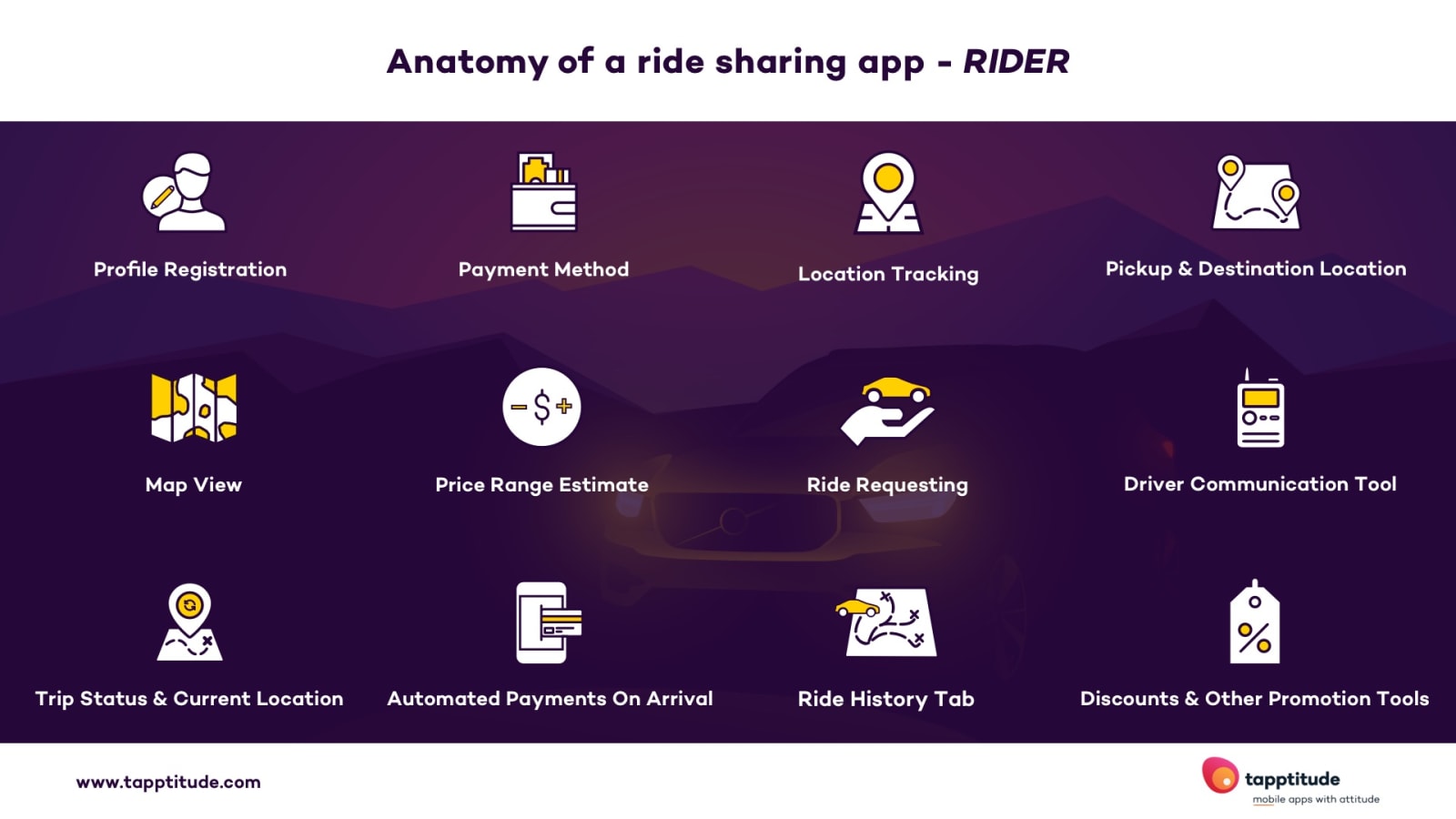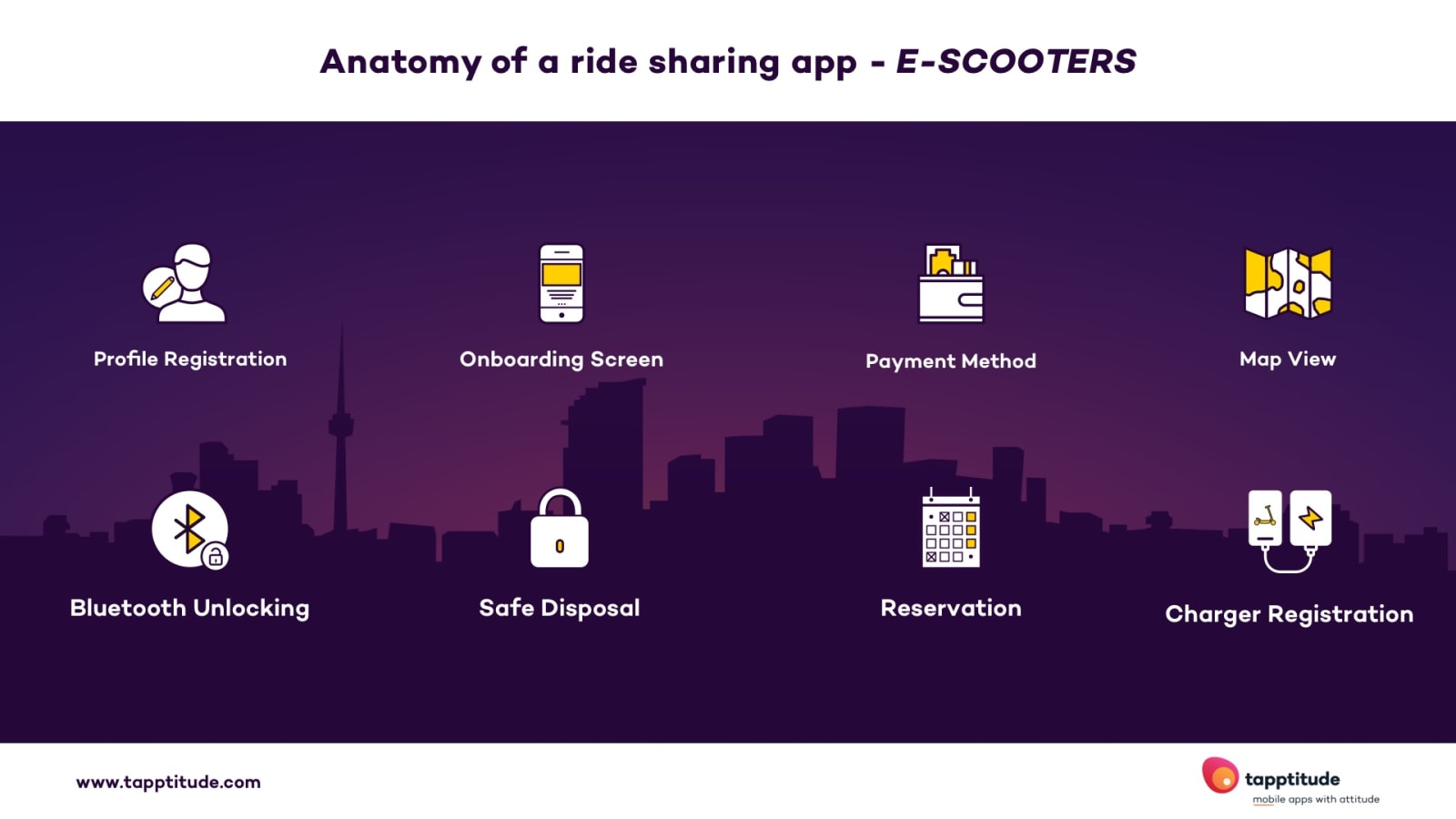Summary
- Ride sharing apps: whim or necessity?
- The basic components of a ride sharing app
- What sets them apart?
- E-scooters: the bright future of ride sharing apps?
- Developing an e-scooter ride sharing app
- What to expect when developing a ride sharing app
The transportation industry keeps reinventing itself, whether we’re talking about smart assistants, self-driving cars, or mobility. In big cities, where traffic seems to be in a perpetual state of congestion, these reinventions lead to and useful mobile apps. We’re talking about ride-sharing apps like Uber, Taxify, Didi or Lyft, which offer you the opportunity to take out your phone, request a ride, and reach your destination in no time.
However, the road to this kind of innovation was not easy. We all know the giants of ride-sharing apps had to fight countless challenges to survive and grow, from legal battles with the local administrations to fierce competition, to the pressures from the old players in city transportation solutions. We’re of course talking about taxi companies, which are trying to reinvent themselves in order to stay on top of all these changes.
Over the past few years, the incumbent ride-sharing apps started facing another serious challenge from a surprising alternative in mobility: electric scooters. Why use cars when you can take an e-scooter from point A to B? This seems to be the right choice, especially in cities with exploding density, where you have to leave early to make sure you will be on time at your destination.
We will explore how this new wave of transportation is influencing the very business model of the ride sharing startups. But first, let’s start from the beginning.
Ride sharing apps: whim or necessity?
When it comes to how many people use ride sharing apps, the numbers do not reach half of the population, with one exception. According to a survey conducted by Dalia Research in 2017, less than 40% used them in Europe, 30% in the U.S., and 50% in Asia. If you think about it, the numbers are not incredibly high, although maybe everyone we know has used a ride-sharing app at some point. For instance, the average American spends around $4,000 a year on hailing rides. Suffice to say, this is a high amount.
However, from a practical point of view, ride-sharing apps are hugely beneficial, and there are several reasons why they are on the rise. For instance:
- Owning a car is expensive. This study made by the Dealroom shows that the average European spends around $1.1 trillion on mobility, out of which 56% is on fuel and maintenance. Not to mention the lack of parking spots and concerns about exhaust emissions.
- Ride shares are a safer solution. When people get hired for a ride-sharing company, they get a full background check. However, ride-sharing is not 100% safe, and we’ve seen that in various cases presented in the media.
- It can be a great alternative source of income.
- No more drunk driving – Now you have the opportunity to find a ride home with just a tap on a screen.
To conclude, we can say that ride sharing apps seem to be quite a necessity. Therefore, let’s get down to business and see what the most used ride sharing apps look like.
The basic components of a ride sharing app
In the past 10 years, ride sharing app businesses have become incredibly valuable companies. For instance, Uber is valued at $60 billion, Lyft at $15.1 billion, Taxify at $1 billion, and Didi, the largest ride-hailing business in China, was valued at $50 billion in the past year.
What’s interesting about these businesses is the fact that they all have something in common, something that serves as the main tool of their business: the app. All of them have two different types of apps to use, one for riders and one for drivers. Now, let’s take them apart and see what each entails.
A rider’s app, in other words, the app used for hailing, contains these features:
- Registration based on a personal phone number and e-mail
- Payment method – both for personal or business use
- Location tracking to find nearby cars
- Pickup & Destination location
- Map view – to see available cars nearby
- Price range estimate
- Ride requesting
- Driver communication tool – chat, notification or call.
- Trip status & current location, with sharing possibility
- Automated payments on arrival
- Ride history tab
- Discounts & other promoting tools
The other end is the driver’s app, which usually contains the following features:
- Personal account based on the e-mail address and phone number
- Driver validation: Licenses, Interviews or other screening methods
- Live Ride Requests
- Location tracking – recommending the closest requested rides
- Map view – to get around the city and estimate the arrival times
- Ride status updates
- Rides history
- Financial management
- Vehicle management
What sets ride sharing apps apart?
We are aware that ride sharing apps have the same pattern and way of working, but we all know that any business that launches on the market has its own unique value proposition, tailored for a target niche. Therefore, let’s see how they differentiate from one another:
- Uber has different types of cars, such as UberX, UberPool, UberXL, UberSUV, UberSelect, UberBlack and UberLUX.
- Taxify also has a business option, where you can ride anything from the most affordable vehicle to top-notch luxury cars.
- Lyft launched an all-access plan and a round-up and donate tab.
- Shebah makes a difference with the fact that all their drivers are female, ensuring this way that all travels are safe for women and children.
- Didi uses Big Data, cloud computing and AI algorithms to maximise traffic capacity.
E-scooters: the bright future of ride sharing apps?
We mentioned at the beginning of the article that e-scooters seem like the best alternative to bulky vehicles that are stuck in continuous traffic congestions. There are already various such apps on the market, such as Bird, Lime, Skip, Spin, Scoot and Ride – all of them electric scooter-rental services. You have probably seen their vehicles buzzing along city streets, all around the world.
You may be wondering, why scooters? Well, there are a few reasons.
- They’re electric. This means no noxious fumes, hence no harm to the environment.
- They’re cheap. Cheaper than grabbing a cab or another ride-hailing service. They cost less than $3 per ride.
- They’re easy to get to. You see, traffic jams in huge cities are a reality. Most of the time you have to get going in time to make sure you’ll be there when the meeting is due. Fortunately, in cities that have bike lanes, e-scooters make your trip faster. No jam, no hassle.
- They’re easy to dispose of. When choosing a bike as a mean of traveling, you have to dock it. Not necessarily with e-scooters, though. You can use them and leave them when you reach the destination, somewhere where they don’t block the traffic. Then, another user finds them, uses them, and so on. There are, however, some apps that require you to leave the scooter next to a bike rack.
Enough chit-chat from our side. Let’s walk you through what an e-scooter ride sharing app looks like and what it contains:
- Registration account based on phone number & e-mail
- Onboarding screen
- Payment method
- Nearby available rides. What’s cool is that you can see the charging percentage of the scooters
- Bluetooth unlocking
- Safe disposal
- Few minutes reservation
- You can also register yourself as a charger – to track scooters through GPS, collect a dozen of them, take them home to charge, and then return them on the streets.
Developing an e-scooter ride sharing app: Ride
This year, we had a lot of fun developing an Australian e-scooter ride sharing app called Ride.
The app was developed in native iOS and Android, using technologies such as Stripe, Twilio, and NFC. The app was developed to be used by riders, chargers and admins. Cool features include the fact that you can find the scooter through the app on a map, ring it, and unlock it via bluetooth. The app also gives you the opportunity to reserve a scooter for a half of hour.
Until now, Ride has had two app store updates, 115 scooters, 258 active users in the first 28 days, 300 rides, 180 official riders, and 6 charges.
To sum up, the mobile app development process went pretty smoothly, the main challenges being third parties involved, a short time for the go-to market, and the lack of scooters for testing. But since our Product Manager had plenty of experience in working on IoT-related apps, she made sure everything went as smoothly as possible.
What to expect when planning to develop a ride sharing app
Before you decide “yes, this is what I’m going to do, I’m going to be the next [insert famous ridesharing company],” there are some things you have to take into account, such as:
Who your target is. There are several opportunities to choose from, so to whom would you like to address your product? For instance, Shebah, a ride sharing app from Australia, focuses on hiring women-only drivers, hence targeting women and children as their sole niche.
How will the product stand out from the alternatives? What will make it special? Why should a ride-sharing veteran pick your app instead of a competing one? Will it be cheaper? Will it have drivers who own a certain type of car?
What user value would your product bring? Safety? Environmental friendliness?
Find your marketing strategy and your unique selling proposition and focus on it. Create the appropriate business model for your app. Look into the most appropriate monetisation. Look into the legal requirements when it comes to launching such a business.
Lastly, find a product partner who can help you either with the whole development process, in case you don’t have an in-house technical team, or with the Product Definition Phase, in case you are not sure about the first 6 questions.
That being said, are you ready to build your very own ride sharing app? Waste no time in reaching out to us to find out how we can turn your product idea into reality.
Do you plan on developing a ride sharing app?

Bianca Gângă
Content Marketing Specialist
Bianca always wanted to be a writer - to craft fantastic stories or to be a professor at an Ivy League university. But since life decided that wasn't the path she should take, she yelled "PLOT TWIST" and became a communication professional, having the chance to work with challenging projects. She enjoys it, nonetheless, but still believes there is a huge need for dragons.

















